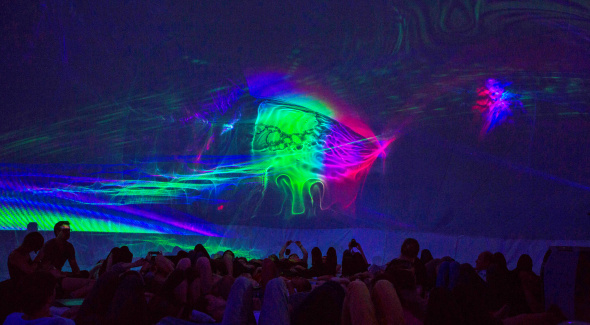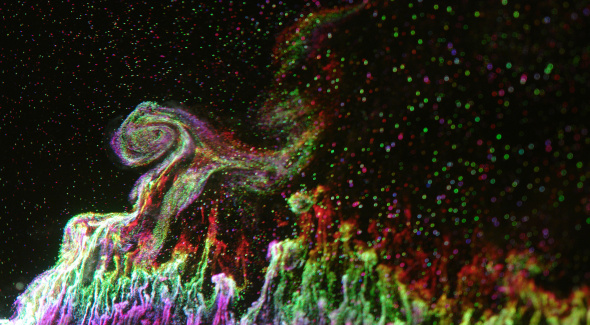Evelina Domnitch & Dmitry Gelfand
Evelina Domnitch (b. 1972, Minsk, Belarus) and Dmitry Gelfand (b. 1974, St. Petersburg, Russia) create immersive artworks that simultaneously comprise scientific experiments, multi-sensory environments and philosophical inquiries. The duo’s installations and performances have emerged through unorthodox collaborations with pioneering research
groups, including LIGO (Laser Interferometer Gravitational Wave Observatory), the Atominstitut (TU Vienna), and RySQ (Rydberg Quantum Simulators). They are recipients of the Japan Media Arts Excellence Prize (2007), the Meru Art* Science Award (2018) and five Ars Electronica Honorary Mentions (2007, 2009, 2011, 2013, and 2017). Their artworks have been presented at Martin-Gropius-Bau (Berlin), Kiasma (Helsinki), MAXXI (Rome), AxS Festival (Los Angeles) and the Venice Biennale.
When we initiated our artistic practice about twenty years ago, we established a variety of constraints. To propel our departure from art’s age-old infatuation with frozen objects, we precluded the use of solid, fixative and recording media in favour of liquids, gases, and plasmas permeated by acoustic vibrations and light emissions. Our conceptual constraints eventually led to the creation of Camera Lucida: Sonochemical Observatory (2003-2008), an artwork exploring the paradoxical phenomenon of sonoluminescence. After vanishing in the impenetrable darkness surrounding the installation, the visitor gradually perceives an undulating cosmos of glowing sound fields. In a spherical chamber filled with 60 litres of water, acoustically imploded air bubbles cyclically shrink to the size of 100 nm, at which point they reach temperatures as high as those found on the Sun and emit picosecond flashes of light. There has yet to be a conclusive model accounting for the nearly trillionfold energy amplification underlying sonoluminescence.
We made a leap from collapsing microbubbles to macrobubbles of soap film in 10 000 Peacock Feathers in Foaming Acid (2007). As a multi-colour laser beam enters a soap bubble membrane (the chemical ancestor of a living cell’s lipid membrane), it surprisingly splits up into a bundle of optical tracks known as polariton-solitons. During the performance, these laser tracks meander through clusters of hemispherical bubbles, which serve as molecule-thin lenses for a 360° laser projection. Presented in planetariums and other dome-shaped environments, the projection envelopes the audience in an unfathomable magnification of the electrochemical, optical and fluid dynamics within the sensitive skin of a bubble.
In 2016 the primordial foam resurfaced in one of our most challenging endeavors, Luminiferous Drift. Developed in collaboration with Jean-Marc Chomaz of Laboratoire d’Hydrodynamique (École Polytechnique Paris, France), Hui Lab (University of California, Irvine), Huck Group (Radboud University, The Netherlands), and composer Richard Chartier, Luminiferous Drift envisions the climate of a hypothetical planet punctiliously traced by bioluminescent protocells. By means of a microfluidic chip, an enzyme-regulated chemiluminescent solution is injected into a vegetable oil membrane. The resultant double-emulsion protocells are released into a rotating bath of water that recreates Saturn’s hexagonal polar vortex.
Another liquid evocation of celestial dynamics, ER = EPR (2017) was a collaboration with LIGO (Caltech), Jean-Marc Chomaz and composer William Basinski. Two corotating vortices, joined together by a slender vortical bridge, drift through an enormous aquarium. Shining through the water surface, an expanded laser beam transforms the vortex pair into a moving lens that upwardly projects two black holes encircled by shimmering halos. Vortices may collide with one another (as in the gravitational wave detections at LIGO), and if the “wormhole” link between them rips apart, the black holes immediately dissipate. ER = EPR refers to the mind-bending conjecture of Juan Maldacena and Leonard Susskind, equating wormholes with quantum entanglement.
Evelina Domnitch and Dmitry Gelfand




